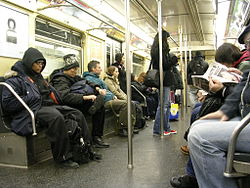R32 (New York City Subway car)
| R32 (New York City Subway car) | |
|---|---|
 | |
 Interior of an R32 car. | |
| Constructed | 1964-1965 |
| Number built | 600 |
| Number in service | 290 |
| Number scrapped | 310 |
| Specifications | |
| Car length | 60 ft 3 in (18.4 m)[over coupler faces] |
| Platform height | 3.76 ft (1.1 m) |
| Doors | 8 |
| Braking system(s) | WABCO RT2 SMEE braking system, A.S.F. simplex unit cylinder clasp (tread) brake |
The R32 is a New York City Subway car model built in 1964-5 by the Budd Company in Philadelphia for the IND/BMT B Division. These cars were the first mass-produced stainless steel cars built for the New York City Subway. Their horizontally ribbed, stainless exteriors earned the cars the nickname Brightliners. They are the oldest subway cars in use today.
The designation R32 is derived from the contract number under which the cars were purchased. They were originally assigned to the BMT Southern Division service only, initially on the Brighton Line express service (Q train) and the Sea Beach Line (N) train, later seeing service on the West End Line (T and TT trains).
The R32 contract was divided into two subcontracts of 300 cars each: the R32's and R32A's. The R32A's were funded through the proceeds of a revenue bond while the R32's were paid for out of the 1963-64 New York City capital budget. The two subcontracts differed only in interior lighting (R-32 Interior Lighting: [1], R-32A Interior Lighting featuring backlit ad-signs [2]).
In 1963, the New York City Transit Authority (NYCTA) contracted with Budd for 600 IND/BMT cars (300 pairs), to replace older equipment, including the BMT D-type (Triplex) articulated cars. Budd had bid on previous contract with the NYCTA, but had never won a City contract for a production run of cars until the R32s, as Budd built only stainless-steel equipment, and the TA refused to allow a differential in competitive bids for this higher-quality construction.
Budd won the contract by offering the lowest bid of $117,000 per car. Budd low-balled the price to win the contract and introduce stainless steel equipment to the modern New York City subway system, a plan that met with limited success. NYCTA allowed a premium for subsequent stainless steel contracts, and all subsequent subway equipment was at least partly stainless construction. However, the Budd Company never benefited from the change, as Budd failed to win further contracts from the NYCTA and the company has since halted production of railroad cars.
Four of these cars (3946-3949) were equipped with Pioneer trucks using disk brakes. The trucks were later replaced with standard trucks in 1976. [3]
In 1987 to 1990 the R32 cars were rebuilt by Morrison Knudsen at its shops in Hornell, New York. Ten R32 cars, which have since been retired, were rebuilt by General Electric in its Buffalo, New York facility. During the rebuilding process, the route and destination rollsigns located above the storm doors were removed and replaced with flipdot electronic route signs. The distinctive marker lights were also removed.
The R32s are numbered 3350-3949. One car, originally numbered 3659, lost its even-numbered mate in an accident, so it was rebuilt as an even-numbered car and renumbered to 3348.
After their refurbishment, R32 and R32A cars were renamed R32 Phase I, R32 Phase II and R32 GE. The R32 Phase I cars (re-built by Morrison Knudsen) have WABCO Air Brake packages, GE Master Controllers (Throttle) and Thermo King HVAC units. The R32 Phase II cars (also re-built by Morrison Knudsen) have NY Air Brake equipment, Westinghouse Master Controllers and Stone Safety HVAC units. Since the cars were sent out to be overhauled based on how poorly they were performing (bad cars first) there are regular R32s and R32As which are Phase I and Phase II. There are also about a dozen or more pairs which are comprised of R32 and R32A mixes. The R32 GE's are slightly different from their Phase I and II brothers in the fact that they still retain their original traction motors, feature backlit ad signs and their Bulkhead designs differ somewhat. [4][5]
Today, the R32s continue to provide service 44 years after their introduction, despite a nominal design service life of 35 years. Their durable stainless construction will be a factor, demonstrating that a premium for such construction was warranted. They run primarily on the E line, but also can be seen on the F and R.
The incoming R160 fleet will replace all of the R32 fleet. The 10 GE and all Phase II R32s have been retired. In early 2008, some of these cars were stripped and sold as artificial reefs. As of July 2008, pair 3352-3353 is at the New York City Transit Museum[6].
References
- Sansone, Gene. Evolution of New York City subways: An illustrated history of New York City's transit cars, 1867-1997. New York Transit Museum Press, New York, 1997 ISBN 978-0963749284
